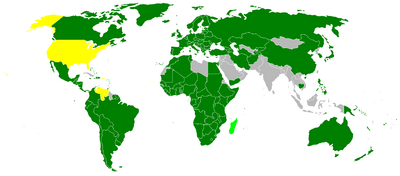Convention Relating to the Status of Refugees facts for kids
The United Nations Convention Relating to the Status of Refugees is an international agreement. It helps to decide who is a refugee. It also lists the rights of people who are given asylum. Asylum means they are allowed to live in another country because it is not safe in their home country. The Convention also explains what countries must do to help refugees.
The Convention also says who is not considered a refugee. For example, war criminals are not protected by this agreement.
Contents
History of the Refugee Convention
This important agreement was approved at a special United Nations meeting on 28 July 1951. At first, it was mainly about helping European refugees after World War II. It had some limits on how long it would last and who it would protect.
However, in 1967, a "protocol" (which is like an official change or addition) was made to the Convention. This protocol removed the old limits. This meant the Convention could now help all refugees, no matter where they came from or when they became refugees.
Because this Convention was approved in Geneva, people sometimes call it "the Geneva Convention." But it is different from the more famous Geneva Conventions. Those other conventions are about rules for how countries should behave during wars.
Denmark was the first country to officially agree to the treaty. This happened on 4 December 1952. Today, 147 countries have agreed to follow the Convention, the Protocol, or both. You can see these countries on the map on this page.
What Is a Refugee?
Chapter I of the Convention, especially Article 1, explains who a refugee is. This part was updated by the 1967 Protocol.
It says a refugee is someone who has had to leave their home country because they are afraid of being persecuted. Persecution means being treated very badly or harmed. This fear must be for certain reasons, such as:
- Their race;
- Their religion;
- Their nationality (the country they belong to);
- Being part of a specific social group; or
- Having political beliefs that their government does not like.
If they are outside their home country and cannot or will not go back because of this fear, they are considered a refugee.
Rights of Refugees
The Convention lists many rights for refugees. These rights help refugees live safely and with dignity in their new country.
Legal Rights
Chapter II (Articles 12 to 16) talks about the legal rights of refugees. These include:
- The right to own property (things they own).
- The right to freedom of association. This means they can join any social group or political party they want.
- The right to use the courts to protect their rights.
Working Rights
Chapter III explains refugees' rights to work:
- Article 17 says refugees have the right to "wage-earning employment" (the right to work for pay).
- Article 18 says they also have the right to be "self-employed" (to work for themselves).
- Article 19 gives refugees the right to work in "liberal professions" (like doctors or lawyers).
Daily Life and Support
Chapter IV focuses on refugees' rights related to their daily lives and well-being:
- They have the right to get food if it is rationed (Article 20).
- They have the right to a place to live (Article 21).
- They have the right to public relief (help from the government) (Article 23).
- They have the right to good working conditions and social security (like health care or unemployment benefits) (Article 24).
Protection from Harm
Chapter V (Articles 25 to 34) talks about important legal protections for refugees. These articles help make sure refugees are safe in their new country.
- Article 31 says that if a refugee enters a country illegally because they are escaping danger, they should not be punished for it.
- Article 32 says a country should not make a refugee leave just because of national security or public order. There must be a very specific and serious reason to make them leave.
- Article 33 is about "Prohibition of expulsion or return." This is also called "refoulement" (a French word). It means no country can send a refugee back to their home country if their life or freedom would be in danger there. This is a very important protection.
- Article 34 says that when a country takes in refugees, it should do its best to help them assimilate (fit in) and become naturalised (become citizens of their new country).
Related pages
See also
 In Spanish: Convención sobre el Estatuto de los Refugiados para niños
In Spanish: Convención sobre el Estatuto de los Refugiados para niños


